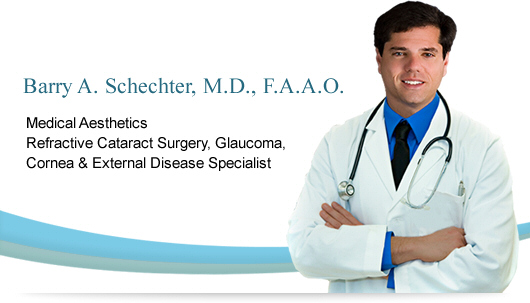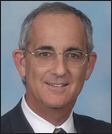Newsletter Issue 11 | Mar 2012
Florida Eye News and Views

Dear Readers:
It’s obvious we are ‘in season.’ Traffic is heavy, restaurants are crowded and people seem to be non-stop these days. All the more reason to take a few minutes and sit back, relax and read what’s new at Florida Eye in our newsletter.
March is Low Vision and AMD Awareness Month, so we’ve included some information we hope you’ll find useful about these conditions which affect the eyesight of millions of Americans. As always we also have updates on our clinical trials and any other news we think you would like to read about.
An exciting new development on the cosmetic front — Dr. Barry Schechter has introduced the Ouchless Needle to his patients. No more fear of needles at Florida Eye! Read all about this fabulous new device, exclusive to our ophthalmology practice, which takes the pain out of cosmetic filler injections (and therapeutic Botox used for medical purposes). Amazing…
On behalf of all of us at Florida Eye I wish you a safe and happy spring season.
Best,

Gwen Cohan
Director of Marketing & Public Relations
In this Issue:
Age Related Macular Degeneration »
Update on Current Clinical Trials »
A Message from Prevent Blindness America »
Cosmetic News at Florida Eye »
Age Related Macular Degeneration/Low Vision
What is AMD?
AMD is a progressive, usually painless disease that affects the macula, the spot on the retina at the back of the eye responsible for central vision, causing central vision to blur, but leaving peripheral vision intact. Thus, AMD does not lead to total blindness.

There are two types of the disease: dry (atrophic) and wet (neovascular). It’s possible to experience the wet type in one eye and the dry type in the other,” says Dr. Randy Katz, Florida Eye’s Macular Degeneration & Diabetic Retinopathy Specialist, who also points out that in addition, the dry type can progress to wet in approximately 10-15% of cases.
Dry AMD affects approximately 85-90% of individuals with AMD. Its cause is unknown, it tends to progress more slowly than the wet type, and there is not — as of yet — an approved treatment or cure. In dry AMD, small white or yellowish deposits, called drusen, form on the retina, beneath the macula, causing it to deteriorate or degenerate over time.
Wet AMD affects approximately 10-15% of individuals with AMD, but accounts for approximately 90% of all cases of severe vision loss from the disease. In wet AMD, abnormal blood vessels under the retina begin to grow toward the macula. Because these new blood vessels are abnormal, they tend to break, bleed, and leak fluid, damaging the macula and causing it to lift up and pull away from its base. This can result in a rapid and severe loss of central vision.

Early detection and treatment is the best defense against losing your vision. If you are at risk for macular degeneration, Dr. Katz stresses the importance of seeing your ophthalmologist for a complete eye exam at least every one to two years. Vision loss does not have to mean loss of independence or quality of life. If you have low vision, ask your ophthalmologist about low vision rehabilitation. He or she can provide low vision services or refer you to an optometrist who specializes in low vision treatments.
National Clinical Trial Updates
From Dr. Barry Schechter:
We are currently enrolling patients for one blepharitis study which will be six months long. Patients must be over 18 and have symptoms. Patients will be paid $30.00 per completed visit with a total of ten visits.
From Dr. Randy Katz:
We have a wet AMD for treatment naïve patients that is Lucentis plus a study drug.
Future Studies…
We will be having another wet study coming up and another dry study as well. We will send out an email when these studies open.
As with any of our studies at Florida Eye, if you refer patients and they are enrolled, we will update you on the progress of your patient and return the patient to your care at the end of the study. The sponsor covers all expenses and costs of these trials.
If you would like to discuss these studies further, please contact our study coordinator Debbie Rankin at (561) 736-5055.
A Message From Prevent Blindness America

We need your help! Congress is currently working on funding for vision and eye health programs for Fiscal Year (FY) 2013, which begins this October. During this critical time, Congress needs to hear from YOU, the Eye Care Action Network (Eye CAN), in support of vision and eye health programs that preserve sight and prevent blindness!
Prevent Blindness America is working diligently to secure FY 2013 funding for sight-saving programs at the Centers for Disease Control and Prevention, the Maternal and Child Health Bureau and the National Eye Institute. An estimated 80 million Americans have a potentially blinding eye disease, 3 million have low vision, 1.1 million are legally blind, and 200,000 are more severely visually impaired. While vision impairment and blindness are among the most feared disabilities, effective public health initiatives can dramatically decrease these numbers.
Be a voice for vision! Email your Members of Congress and ask them to join with us in support of vision and eye health!
Cosmetic News
Dr. Barry Schechter is the first and only ophthalmologist in Boynton Beach to offer the ‘Ouchless® Needle’ in his cosmetics practice. A quick spritz of a vaporizing coolant is the key to the Needle, a device created to take the pain out of cosmetic injections.
“By applying the coolant it makes the nerves that transport the sensation of pain, it distracts them and makes the needle go through without the nerves knowing so much about it,” explains Dr.Schechter.
To prevent needle pain, doctors can use numbing creams, but it usually takes anywhere from twenty to thirty minutes for the creams to take effect, meaning more waiting time for the doctor and the patient. Numbing creams also have other disadvantages. “The numbing cream might block some fine wrinkles so they can’t be seen as well,” says Schechter. “And when an anesthetic is injected, that can also produce some swelling in the areas to be injected, which can also be a hindrance. With the ‘Ouchless Needle’ we can see a patient’s wrinkles and issues as they really are.”
Learn more about the ‘Ouchless® Needle’ and see the video at DrBarrySchechter.com. To book an appointment for cosmetic fillers with the Needle technique call Derk at (561)736-5067.
Cosmetic Specials at Florida Eye
Visit DrBarrySchechter.com for cosmetic specials and additional information.

Barry A. Schechter, M.D., F.A.A.O.
Refractive Cataract Surgery, Glaucoma, Cornea & External Disease Specialist
Eye Care Questions
Dear Dr. Friedman:
My daughter is six months old and he has blocked tear ducts in both of her eyes. She has had this condition since birth. After visiting several doctors all have recommended surgery, but I’m not sure I want my daughter to have such an invasive procedure. I’ve been told time may take care of the situation naturally. Any ideas would be most appreciated.
Answer

There really is no correct answer for this question. It really is a personal decision. Some surgeons elect to do the procedure between 6 and 12 months of age, whereas many others will wait until one year of age. Earlier surgery has the advantage of fewer months of symptoms, whereas waiting for delayed surgery has the substantial chance that the condition will spontaneously resolve and no surgery is actually needed. You should discuss the two options and why your ophthalmologist is suggesting one or the other course. Again, there is no significant difference between the outcomes from these two approaches for at least the first two years of life.
Dear Dr. Gorscak:
Is an iridectomy the only way to prevent closed-angle glaucoma? Are there less-invasive ways to achieve the same result?
Answer

Laser iridectomy is the most technically advanced procedure available today for treating this type of glaucoma. There are certain eye drop medications that can produce similar results, but often medications don’t provide the permanent change that is necessary. In some forms of angle closure, even the laser iridectomy may be insufficient and other treatments with medication or surgery may be necessary to consider. Your ophthalmologist will discuss all options with you before embarking on any course of treatment.
Final Tidbits: Update on Lions Club Eyeglasses Collection

Special thanks to those in our community — our patients, doctors and friends who continue to drop off used or unworn eye and sunglasses to our Boca, Wellington and Boynton locations. To date we have collected more than 3,000 pairs of glasses, which are being recycled and redistributed to those in need throughout the world.
